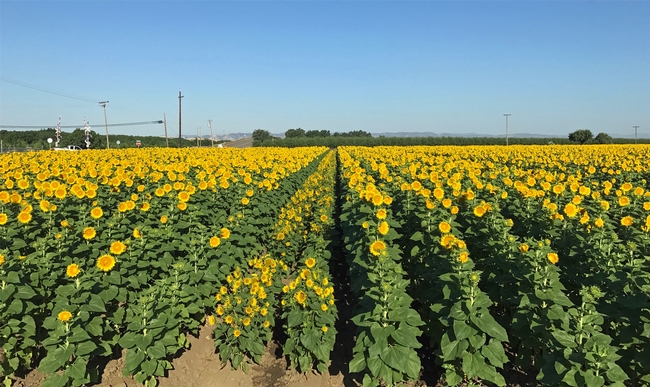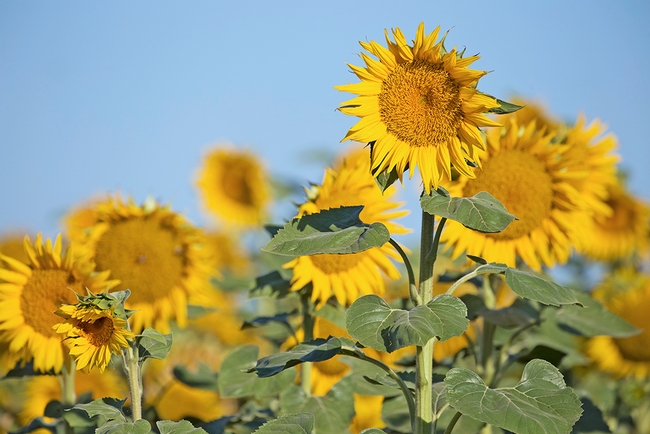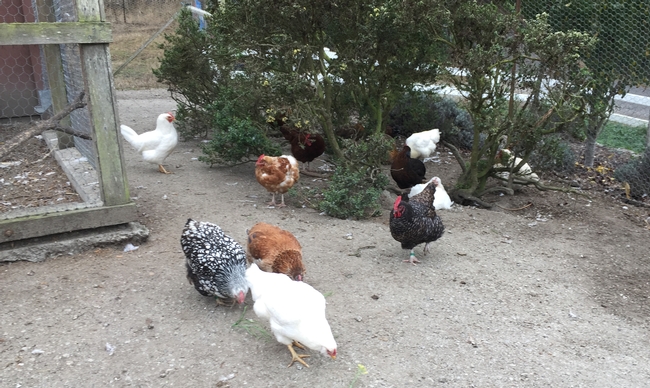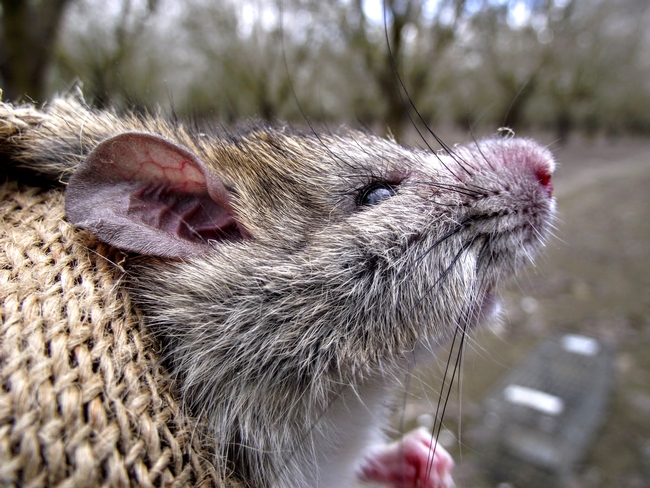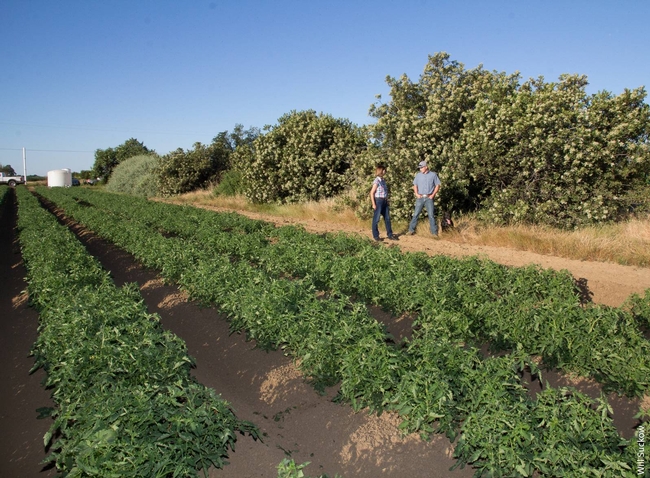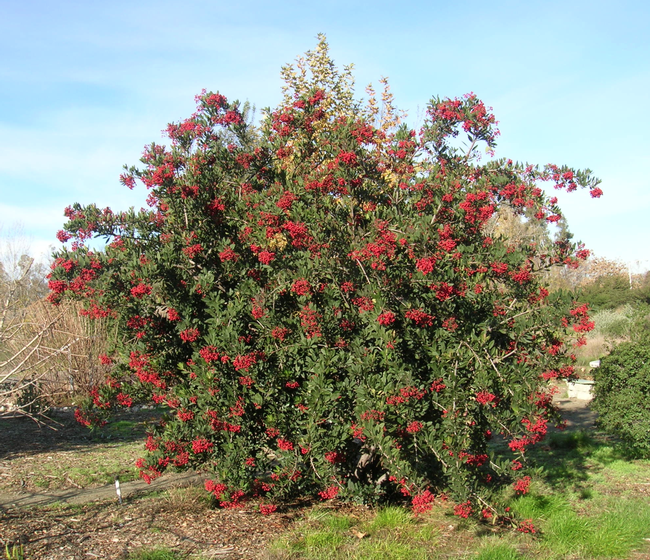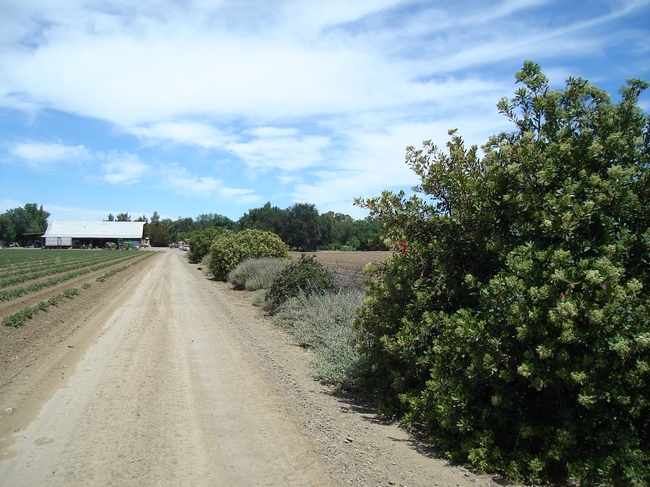Posts Tagged: Rachael Long
Radiant daisy-like sunflowers produce a valuable crop with little water
Sweeping acres of striking golden flowers may soon grace California's desert southwest. UC Cooperative Extension irrigation specialist Khaled Bali believes sunflowers may be an ideal crop for the state's most punishing agricultural region.
California produces more than 90 percent of the country's hybrid sunflower planting seed, which is shipped around the nation and world. The seed is used to grow sunflower seeds for a healthy snack or salad topper, and for seeds that are expressed into sunflower oil, valued for its clean taste and polyunsaturated fat.
Most California seed is produced on about 50,000 acres in the Sacramento Valley. But the plant's low water use and early maturity hold promise for production in Southern California's low desert.
Bali's research began two years ago with 1,800 plots of sunflowers, nearly 300 different genotypes, at the UC Desert Research and Extension Center in Holtville. All plants were well-watered for four weeks before drought treatment started. In 2016, the trial plots were irrigated at 60 percent of the area's ETo (the full amount of water used by well-irrigated, mowed grass in that environment), and at 100 percent.
“Sunflower is a California native species grown as a hybrid seed crop,” Bali said. “With limited water, we wanted to look at varieties that tolerate drought and stress.”
That year, Bali found significant variation in yield across the varieties, but no difference between plots that received 60 percent of ETo and 100 percent
“I've been doing deficit irrigation for a long time,” Bali said. “I never expected that.”
For the 2017 season, the 60 percent ETo plots were dropped to 10 percent to better understand the implications of severe drought on the sunflower cultivars.
“The emphasis in 2017 was to intensify our drought treatment, giving less water earlier and to quantify the genotypes' drought avoidance strategy by digging up roots and using computer image analysis to determine root traits,” Bali said.
Bali attributes the sunflower crop's low water needs to its deep tap root and crop production timing. Sunflower in the low desert may be planted from January to February, and harvested in May and June.
“Sunflower water needs are relatively low since they are harvested before the hottest part of the summer,” Bali said.
His research is continuing in 2018.
A new UC publication, Sunflower Hybrid Seed Production in California, is now under review and is expected to be available to producers in fall 2018. Written by UC Cooperative Extension advisor Rachael Long and colleagues, including Bali, the publication outlines crop production standards, land preparation, fertilization, pest management, harvesting and more.
Long said sunflowers are favored for crop rotations because they help in long-term management of weeds and diseases, the plants add biomass to the soil after harvest, and they are a profitable specialty field crop.
Read more about California sunflowers in a Green Blog post by Rachael Long, Sunflower seeds are boosting California's ag economy.
May 2018 News Clips
Mien farmers get advice for growing strawberries in Yolo County
(Woodland Daily Democrat) ANR news release, May 31
Abnormal Weather Takes a Toll on California Olive Crop
(Ag Net West) Brian German, May 30
The late winter freeze caused significant issues for several different commodities throughout the state and has been especially problematic for the California olive crop. The fluctuating temperatures have created substantial concern among the industry as bloom looks to be far below normal levels.
“Overall we're a little on the pessimistic side. The bloom, on the whole, has been pretty poor, many orchards actually have a very light, to next to no bloom at all,” said Dani Lightle, Cooperative Extension Orchard Systems Advisor for Glenn County. “There's an orchard here or there that looks pretty good, but on the whole, it is a little bit dismal.”
http://agnetwest.com/weather-takes-toll-california-olive-crop/
How Avocados Define LA and the Secret to Making the Best Damn Avocado Toast
(LA Taco) Gab Chabran, May 29
…Eric Focht who is a staff research associate in the lab of Mary Lu Arpaia at UC Riverside through UC Agriculture and Natural Resources and the Department of Botany and Plant Sciences tells L.A. Taco that the recent avocado economy boom is “similar to what we see today with something like bitcoin.” He helps run a breeding program at UCR studying different avocados varieties, focusing mostly on Hass avocados but also looking at other less known versions of the popular fruit.
In short, he is working on breeding the perfect avocado that tastes great and is easier, faster, and less water-dependent to grow. This year is shaping out to be a good one for avocados, but this issue is always one to keep in mind.
Focht states that in the future, there will likely be more variety available in the mainstream marketplace. One varietal that Focht gets excited about is the Reed avocado which has now been popping up in places such as Whole Foods. It's known for its round, dinosaur egg shape and is about the size of a softball. It has a relatively large seed but the edible flesh is sometimes double or even triple that of a Haas that can make a lot more people happier per individual fruit.
http://www.lataco.com/how-avocados-define-l-a-and-the-secret-to-making-the-best-damn-avocado-toast/
Amazing graze
(Chico News & Review) Ashiah Scharaga, May 24
When drifting clouds dapple the sky and vibrant wildflowers—tickled pink buds, honey-hued petals and virent stems—awaken in the verdant fields of Table Mountain, explorers quicken their pace. They spot trickling streams and grazing cattle. Occasionally, they look straight down, turning anxious eyes to their mud-slicked heels—did they step in one of the fertile cow-pie mines littered across the landscape?
That may seem a nuisance, but it's a necessity. Tracy Schohr, a livestock and natural resources adviser for University of California Cooperative Extension, said the natural magic of the popular Butte County recreational spot is made possible because of a long-standing grazing program. “If cattle were not actually on Table Mountain Ecological Reserve,” she said, “essentially those invasive species would choke out those native plants, and they wouldn't be there.”
… In the past, grazing was misunderstood and primarily viewed as destructive, said Dave Daley, a fifth-generation Butte County cattleman and associate dean of Chico State's College of Agriculture. He credits changing perspectives to the development of grazing science, fueled by people such as Schohr and Kate Wilkin, a UC Cooperative Extension forestry, fire science and natural resource adviser for Butte, Yuba, Sutter and Nevada counties. (Schohr covers Butte, Plumas and Sierra counties.)
https://www.newsreview.com/chico/amazing-graze/content?oid=26315855
Sheep Shearing 101: Why Aspiring Shavers Flock to This California School
(KQED) Tiffany Camhi, May 23
…“We try to get the students shearing the first day because they make a lot of mistakes,” says John Harper, head of the UC Cooperative Extension Sheep Shearing School in Hopland.
Harper says if you can make the right moves with your feet, everything else falls into place.
“We're dancing instructors,” says Harper. “It's like 'Dancing With The Stars' on steroids, but with sheep.”
Around this time of year, hundreds of thousands of sheep in California need to have their wool shaved off. But Harper says there's a shortage of sheep shearers worldwide.
That's why he started the school in Hopland about 25 years ago.
Dan Macon of the California Wool Growers Association says the growing popularity of backyard flocks in California (usually just a handful of sheep) is adding to the demand for shearers, too.
“Infrastructure of the sheep industry is a key component,” says Macon. “Having people with that kind of skill and willingness to work hard is desperately needed.”
AUDIO: Hey, Salad Lovers: It's OK To Eat Romaine Lettuce Again
(NPR Morning Edition) Allison Aubrey, May 23
…After a big foodborne illness outbreak linked to baby spinach back in 2006, the leafy greens industry put in place a number of procedures to prevent contamination. "Prevention became the major focus after that outbreak," says Michele Jay-Russell, a food safety researcher at the University of California, Davis.
"They set up intensive testing protocols to monitor water quality," Jay-Russell says. The industry also agreed on standardized setbacks — or buffers — to separate growing fields from livestock operations, which can be a source of E.coli contamination. "You want a safe distance from where you're growing fresh produce and where you have concentrations of animals, like on a feedlot or dairy," she says.
Are avocados toast?
(Grist) Nathanael Johnson, May 22
…When Katherine Jarvis-Shean was a doctoral candidate researching the decline of cold winters a few years back, she thought more farmers should be freaking out. “I used to think, ‘Why aren't you guys more worried about this? It's going to be the end of the world.'”
After all, many fruit and nut trees require a good winter chill to bear fruit. But after spending a few years as an extension agent for the University of California — working directly with farmers and translating science into techniques they can apply on the land — she understands better. It comes down to this: Farmers have a ton of concerns, and the climate is just one of them.
“If you decide what to plant based on climate, but then can't make the lease payment, that's not sustainable,” Jarvis-Shean said.
https://grist.org/article/whatll-we-eat-in-2050-california-farmers-are-placing-bets/ https://www.wired.com/story/are-avocados-toast/
Lanternflies Eat Everything in Sight. The U.S. Is Looking Delicious.
(New York Times) Zach Montague, May 21
…Native to Asia, lanternflies first appeared in Pennsylvania in 2014. Despite a quarantine effort, they have also been discovered in small numbers in New York, Delaware and Virginia.
… “Most pests deposit their eggs on their host plant, or very close, so they already have food available,” said Surendra Dara, an adviser at the University of California Cooperative Extension.
“Those that have the advantage of being able to lay eggs on non-plant material obviously have a better chance of surviving and spreading,” he added.
https://www.nytimes.com/2018/05/21/science/lanternflies-pennsylvania-crops.html
Garbanzos are catching on in Yolo County
(Woodland Daily Democrat, Ag Alert) Bob Johnson, May 19
…“The largest part of our crop goes to canning, maybe 90 percent,” said Paul Gepts, UC Davis plant sciences professor and legume breeder. “California can only compete with high quality products. We have other varieties with higher yields, but the seeds are too small. The growers get a premium for larger, high quality seeds.”
Gepts developed the two newest UC garbanzo varieties, Vega and Pegasus. Both have large, attractive seeds well suited for the canning market, and both have resistance to Ascochyta blight, a fungal disease that can devastate the crop.
… “I think growers are more interested in garbanzos because it's a winter crop, and wheat prices are low,” said Rachael Long, UC Cooperative Extension farm adviser in Sacramento, Solano and Yolo counties. Long is finishing up UC's first Garbanzo Production Manual, which should be available before the end of the year.
http://www.dailydemocrat.com/article/NI/20180519/NEWS/180519787
A French Broom smack-down
(Napa Valley Register) Elaine de Man, May 18
…If we all pull together and pay attention, we can eradicate French broom and send it packing. But it's going to take many, many hands and a concerted effort. It's going to take a village.
1. U.C. Agriculture and Natural Resources, Statewide Integrated Pest Management Program, http://ipm.ucanr.edu/PMG/PESTNOTES/pn74147.html
Kale, Not Jail: Urban Farming Nonprofit Helps Ex-Cons Re-enter Society
(New York Times) Patricia Leigh Brown, May 17
Even by the standards of the Bay Area, where sourcing local, organic chicken feed is seen as something of a political act, the spectacle of 30,000 fruit and nut trees being tended by formerly incarcerated orchardists is novel.
…Jennifer Sowerwine, an urban agriculture specialist for the University of California Cooperative Extension at Berkeley, said that Ms. Haleh and Mr. Raders have “shifted the conversation around food justice.”
“It's not just about food security, but the security of providing living wages,” she said. That's no mean feat in a foodie monoculture.
https://www.nytimes.com/2018/05/17/business/urban-farming-exconvicts-recidivism.html
Tough winter weather devastates local cherry, blueberry crops
(Bakersfield Californian) John Cox, May 16
It's hard to say at this point just how much damage blueberry fields and cherry orchards sustained during the winter, said Ashraf El-kereamy, viticulture and small fruits advisor with the University of California Cooperative Extension in Kern County.
Machines take over for people at Napa vineyard
(Capital Press) Tim Hearden, May 14
In the heart of the Napa Valley, a vineyard produces fine Cabernet Sauvignon with virtually no help from laborers.
The 40-acre “touchless vineyard” was established by Kaan Kurtural, a University of California Cooperative Extension specialist who has devoted much of his career to improving production efficiency in vineyards as labor shortages have worsened.
…When Kurtural started experimenting with vineyard automation 10 years ago, his primary goal was to save growers money in labor costs, he said. But since then, research has shown that grape quality is superior, largely because the tall canopy protects grapes from sun damage, he said. The system also uses less water than others, he said.
Dozens of strawberry growers gather in Santa Maria to learn latest industry advancements
(KSBY Staff) May 9
More than 100 farmers and growers took park in a meeting teaching them on the best way to grow a healthy strawberry.
The University of California put on the annual event which was free to the public.
Growers discussed improvements handling weeds, disease, and insects.
The Santa Maria Valley is the second largest strawberry growing area in California after the Salinas Valley.
The crop means a lot to people in Santa Maria.
"We've got a number of challenges to the California strawberry industry and we're doing are best to work together," said Steven Fennimore of University of California Cooperative Extension Agriculture and Natural Resources. "I'm optimistic that we'll find some satisfactory solutions."
Growers talked about all kinds of different ways to boost their crop including ways of using images from aircraft to detect stress in plants.
Pesticide Use on California Farms at Near-Record Levels
(Fair Warning) Paul Feldman, May 9
…Some experts say long-term changes in the mix of items farmers produce in California, including increases in almonds and other high value crops, give the agriculture industry the incentive to use more pesticides. Such crops present “a larger economic risk if pests are not controlled,”said Brad Hanson, a weed specialist at the University of California, Davis, plant science department.
Jim Farrar, director of the University of California's statewide integrated pest management program, added that more pesticides are needed when “you move from something like alfalfa and sorghum for dairies, where cosmetic injury isn't a problem … to something like oranges where if there's a blemish on the rind you get downgraded even if the orange is perfectly healthy.”
https://www.fairwarning.org/2018/05/pesticides/
Cherry growers expect lighter crop yields
(Ag Alert) Ching Lee, May 9,
…Kari Arnold, a University of California Cooperative Extension farm advisor in Stanislaus County, said she's careful not to paint the 2018 cherry season as a disaster year "because it's really not." The crop may not be as robust, she said, but this was somewhat expected, because last year's crop was so big.
What wasn't expected, she said, was the freeze in the spring, which "did cause some damage to flowers." But the damage varied depending on the location of the orchard and whether growers were able to apply frost protection, she added.
"It's still going to be a good crop," she said. "It may not be the same as last year, but they're going to be good cherries. They're probably going to sell at a higher price because there'll be less of them."
She said she's concerned that word of it being a light crop may scare away field help, adding that "it's hard enough to get field labor in the first place anymore, because labor is becoming more and more difficult to come by and more difficult to keep."
http://www.agalert.com/story/?id=11854
Peak Avocado Is Yet to Come
(The Atlantic) Cynthia Graber, Nicola Twilley, May 9
…Its partners in evolution—the giant, elephant-like gomphotheres and three-ton ground sloths that dined on its fruit in return for transporting and then pooping out its giant seed—went extinct soon after the first bipedal apes arrived in the region. Rodents, jaguars, and eventually humans stepped in as dispersal mechanisms, albeit significantly less effective ones. The flourishing avocado forests that carpeted much of Mesoamerica dwindled and died out. And, as Mary Lu Arpaia, who runs the avocado breeding program at the University of California at Riverside, explained, the avocado became a backyard fruit, enjoyed by first the indigenous peoples and later the conquistadors, but rarely cultivated intensively—until recent decades.
https://www.theatlantic.com/science/archive/2018/05/peak-avocado-is-yet-to-come/559883/
Climate change ruining California's environment, report warns
(SF Chronicle) Peter Fimrite, May 8, 2018
“If I were going to look across North America, ground zero for climate change is the Arctic. It is just changing really, really rapidly,” said Steven Beissinger, professor of conservation biology at UC Berkeley. “But California is an important laboratory to understand the effects of climate change on biodiversity.”
https://www.sfchronicle.com/news/article/Climate-change-ruining-California-s-12899272.php
More illnesses with later onset dates linked to romaine outbreak
(The Packer) Ashley Nickle, May 8, 2018
Richard Smith, a University of California Cooperative Extension advisor based in Salinas, also said the outbreak is hurting sales.
“It's having an effect,” Smith said May 7. “This is the problem — lettuce is pretty expensive to grow, and you've got to cover your costs. You can lose money, at this point the bigger growers can afford to lose for a period of time, but then they've got to make it up, and it just makes it hard. We're not sure how the year's going to go.
“I guess the good news is that the consumers are being sophisticated enough to be focusing on the romaine (versus all lettuce) ... The reality is I guess the FDA doesn't want to clear romaine yet because they think that the lettuce from Yuma might have a 21-day shelf life, so until the FDA clears it and then that news gets clearly articulated, I think it's going to be a damper.
https://www.thepacker.com/article/more-illnesses-later-onset-dates-linked-romaine-outbreak
AEI economists say farmers have ‘beef' with Trump
(Hagstrom Report) May 7, 2018
…Daniel Sumner of the University of California at Davis also told The Hagstrom Report that farmers hurt by the administration's trade policies have "a beef" with Trump.
Sumner said that even though the tariffs on Chinese steel and aluminum have not yet gone into effect, California farmers including wine and almond producers are already worried. "Even if the tariffs don't happen, the rhetoric has effects," he said.
Sumner also said that Mexican buyers of U.S. dairy products — "reasonable business people in Mexico" — began months ago to contact New Zealand dairy producers about becoming a supplier because the Mexicans are worried about the impact of the North American Free Trade Agreement renegotiation.
https://www.thefencepost.com/news/aei-economists-say-farmers-have-beef-with-trump/
City Visions: Tech and the future of smart, sustainable farming
KALW, May 7, 2018
Host Ethan Elkind and guests explore the impact of new technologies on our agricultural industry.
What are the biggest challenges to our current food production system? And, how are Bay Area innovators meeting these challenges while promoting sustainability, efficiency and profitability?
Guests:
- Charles Baron, co-founder and vice-president of product at Farmer's Business Network.
- Jaleh Daie, Ph.D., founder and chair of AgriFood Tech and partner at Aurora Equity.
- Glenda Humiston, Ph.D., vice president of University of California's Division of Agriculture and Natural Resources.
http://kalw.org/post/city-visions-tech-and-future-smart-sustainable-farming#stream/0
Workshop planned on Napa fire prevention and best practices
(Napa Valley Register), May 7, 2018
A one-day seminar is planned for May 30 to look at the Napa ecosystem's recovery after the October wildfires and what policies are needed to reduce future fire impacts.
The workshop will be Wednesday, May 30, from 8 a.m. to 3:45 p.m. at Napa Valley College's Performing Arts Center, 2277 Napa Vallejo Highway.
Cost is $15 per person, with registration required at http://ucanr.edu/napafireworkshop2018. For more information, call 530-666-8143.
The program is sponsored by UC Cooperative Extension, Napa County Farm Bureau and the U.S. Department of Agriculture's Natural Resources Conservation Service.
Egg prices plunge as supplies rebound
(Capital Press) Tim Hearden, May 4
Commercial egg prices in California are plummeting, and a slow global economy combined with a rebounding chicken flock after last year's devastating avian flu outbreak are among the contributing factors.
…At first, Midwestern egg producers that didn't want to retrofit their barns simply avoided California. Those that did want to market to California found confusion in what actually constituted a Proposition 2-compliant cage, said Joy Mench, a University of California-Davis animal science professor.
“(T)he wording of Prop. 2 does not allow it to be regulated, so there is no official definition of what it means,” Mench said in an email. “That will have to be decided in the courts, either because there is a lawsuit or because someone is prosecuted.”
In enforcing the initiative, the CDFA uses the federal Shell Egg Food Safety rule, whose space requirement is larger than the United Egg Producer guidelines that most of the other states use, noted Maurice Pitesky, a poultry specialist at the UC-Davis School of Veterinary Medicine.
http://www.capitalpress.com/Business/20160504/egg-prices-plunge-as-supplies-rebound
Farming takes center stage at Yolo County Fairgrounds
Woodland Daily Democrat) Cutter Hicks, May 4
Field trips to the fairgrounds led to a farming experience for students as the Yolo County 4-H and Farm Bureau hosted its 10th annual Farm Connection Day to kick off the Spring Show this weekend.
The four-hour event Friday featured more than 100 agricultural displays and hands-on activities for kids of all ages as nearly 2,500 visitors walked through the gates.
Farm Connection Day was open to the public and more than 200 4-H students teamed up to host the event — with a little help from adult volunteers. Their focus was to teach students of Yolo County the aspects of the organization before judging shows later that day.
DeAnn Tenhunfeld, a Farm Connection Day organizer, said that the attendance was the largest seen since she founded it in 2008.
http://www.dailydemocrat.com/business/20180504/farming-takes-center-stage-at-yolo-county-fairgrounds
Frost damage varied for California nut trees
(Farm Press) Robyn Rominger, May 2, 2018
Some almond growers experienced frost damage from recent freezing conditions, say University of California experts.
“There's really a lot of damage,” says Katherine Jarvis-Shean, UC Cooperative Extension orchard systems advisor for Sacramento, Solano, and Yolo counties. “The earlier varieties really took a hit. Some trees even dropped their nuts due to frost damage. It's pretty bad in some orchards.”
… Bruce Lampinen, UCCE almond and walnut specialist, measured temperatures in an almond trial at Davis, and notes that “Feb. 20 and 24 were the coldest days. It was very problematic because that's when the trees were in full bloom.” At full bloom, temperatures below 28 degrees F. can cause crop loss.
…Phoebe Gordon, UCCE orchard systems advisor for Madera and Merced counties, says, “From what I've seen and heard, the damage has been variable. Some orchards weren't hit that hard, and others were hit very hard. I think it depended a lot on micro-climate and what stage the trees were in. They become more susceptible to frost damage as they transition from dormant to full bloom, and to nut set. I don't think we'll really know until ‘June drop' is finished what the final load is.”
Dani Lightle, UCCE orchard systems advisor in Glenn and Butte counties, says, “Almonds were right in the middle of full bloom when the frost happened. Most of the orchards in my area seem to have escaped. We didn't seem to cross the threshold to where there was heavy damage. Of course, there are exceptions, but by and large we came out better in the end than we thought we would.”
http://www.westernfarmpress.com/tree-nuts/frost-damage-varied-california-nut-trees
New weapon in fight against walnut blight
(Farm Press) Robyn Rominger, May 2, 2018
Walnut growers have a new tool to help manage blight disease in their orchards — Kasumin 2L, manufactured by Arysta LifeScience, is the trade name for kasugamycin, and is available as part of a strategy to control the disease.
The new bactericide was discussed at a recent University of California Cooperative Extension breakfast meeting at Yuba City. “It's great to have another chemistry in the rotational loop for blight management in walnuts,” says Emily Symmes, UCCE integrated pest management advisor.
http://www.westernfarmpress.com/tree-nuts/new-weapon-fight-against-walnut-blight
March news clips
Unprecedented Study Discovers what Urban Coyotes Really Eat
(Care2) Laura Goldman, March 30
Hiking boots, avocados, candy wrappers and fast-food containers. These aren't a few of my favorite things, but they are some of the items found inside the stomachs of dead urban coyotes in Los Angeles and Orange counties.
…Since the study began over a year ago, the researchers, led by Dr. Niamh Quinn, the human-wildlife interactions advisor for the University of California Cooperative Extension, have discovered that cats make up only about eight percent of a coyote's diet.
https://www.care2.com/causes/unprecedented-study-discovers-what-urban-coyotes-really-eat.html
Red blotch grape virus confirmed in Calaveras
(Calaveras Enterprise) Jason Cowan, March 29
Red blotch virus, a DNA infection that decreases a grape's sugar levels on the vine, has been confirmed in Calaveras County, officials said last week.
After confirmed cases of the virus were located recently in El Dorado and Amador county vineyards, University of California Cooperative Extension Farm Adviser Lynn Wunderlich saw what she thought were symptoms of the virus in Calaveras and recommended farmers test for red blotch.
The results came back positive.
http://www.calaverasenterprise.com/news/article_4ebae972-33aa-11e8-ab5c-cb61df3e8deb.html
Raising chickens at home? Get their eggs tested for free
(Daily Democrat) ANR News release
Californians who raise poultry outdoors are invited to get their eggs tested for contaminants.
To find out if harmful substances on the ground that are eaten by hens get passed along in the eggs they lay, Maurice Pitesky, UC Cooperative Extension poultry specialist at the UC Davis School of Veterinary Medicine, is providing free egg testing.
“We're trying to understand the connection between the environment that backyard poultry are raised in and the eggs they are producing,” Pitesky said.
http://www.dailydemocrat.com/article/NI/20180329/FEATURES/180329815
Here's what trade tariffs could mean in Merced County, where nuts are big business
(Merced Sun-Star) Thaddeus Miller, March 28
China has threatened retaliatory tariffs on a select group of exports from the U.S. following President Donald Trump's plan to impose tariffs on steel and aluminum imports.
China's tariffs would first hit U.S. products such as avocados and nuts, with 15 percent duties. Beijing, if officials deemed it worthwhile, could also place 25 percent tariffs on American-made goods such as pork and aluminum.
…"It doesn't really matter which one it is, whether it's alfalfa, almonds or wherever it may go," said David Doll, a farm adviser with the Merced County UC Cooperative Extension. "They're as much political as they are anything else."
Nuts are big business in Merced County, where almonds are the second largest commodity at $578.5 million, according to the 2016 Merced County Crop Report, the most recent available. Almonds, pecans and pistachios bring in tens of millions of dollars more.
Out of every dollar made on a farm in the Central San Joaquin Valley, half pays for salaries and 40 cents goes to pay for supplies, Doll said, citing UC cooperative studies.
"Farms are businesses, and if they aren't profitable they're not going to stay in business," Doll said.
http://www.mercedsunstar.com/news/business/agriculture/article207155554.html
A film you may want your favorite doctor, trainer, chef and lawmaker to see
(Farm Week Now) Mike Orso, March 28
In the documentary “Food Evolution,” scientist Alison Van Eenennaam captures a smartphone selfie image of her with Bill Nye, the “Science Guy,” following a spirited forum in New York City on genetically modified organisms or GMOs. That was three years ago. Now, Van Eenennaam has young people coming up to her asking for selfies.
“If we can engage this next generation with critical thinking skills and trying to get to the bottom of what actually is true, I think we will have accomplished our job,” said Van Eenennaam, a University of California-Davis Extension specialist and one of several scientists featured in the film.
http://farmweeknow.com/story-film-may-want-favorite-doctor-trainer-chef-lawmaker-1-173628
Scientists say regulation stifles many new biotech traits
(Agri-Pulse) Jim Weber, March 28
Federal regulation of agricultural biotechnology needs to be based on risk and not on process, a wide range of scientists and food industry executives agreed at the Agri-PulseAg and Food Policy Summit. Coincidentally, a similar message was delivered a day later by a Council on Agricultural Science and Technology (CAST) task force.
“Scientists have been screaming that for 30 years,” said Alison Van Eenennaam, a cooperative extension specialist in animal genomics and biotechnology at the University of California-Davis. “That's where regulation should be.”
…Although the USDA, universities and small businesses have developed dozens of GE crops – with improved traits ranging from healthier and less allergenic to safer and more environmentally sustainable – and carried many through safety and pre-market testing, almost all have been denied commercial release mainly because of U.S. regulatory obstacles,” according to the CAST task force, led by Alan McHughen, who chairs the Department of Botany and Plant Sciences at California-Riverside.
https://www.agri-pulse.com/articles/10764-scientists-say-regulation-stifles-many-new-biotech-traits
If China Strikes Back On Tariffs, California Tree Nut Exports Could Take A Hit
(CapRadio) Julia Mitric, March 27
California agriculture could find itself caught in the middle of the U.S. — China trade dispute.
After President Trump ordered a 25 percent tariff on imported steel and a 10 percent tariff on imported aluminum last week, China hit back, announcing it may impose a 15 percent tariff on agricultural exports from the U.S.
The U.S. faces competitors for every agricultural product it exports. California wines, for example, compete with wines from New Zealand and Chile. If China hits the U.S. with a 15 percent tariff on wine, that's a problem, explains Dan Sumner, Director of the University of California Agricultural Issues Center.
"We may think California wine is special, but not everybody does,” Sumner said. "And if it's 15 percent more expensive than it used to be because of the tariff, there'll be a substantial reduction in how much gets sold in China."
State senator to honor UC 4-H program
(Morning Ag Clips)
California State Senator Ben Hueso will honor California and Baja California 4-H with a resolution in the State Senate at 2 p.m. April 2 to recognize the cross-border team that established a 4-H Club in Mexicali, Baja Mexico, in January 2017.
Last year, UC ANR Vice President Glenda Humiston signed a memorandum of understanding with the Baja California Secretary of Agriculture Development, Manuel Vallodolid Seamanduras, to offer UC's 4-H expertise to youth south of the border. The agreement increases the academic, scientific, technological and cultural cooperation that are part of UC President Janet Napolitano's Mexico Initiative.
https://www.morningagclips.com/state-senator-to-honor-uc-4-h-program/
Building an IPM Program to Fight Fruit Flies
(Growing Produce) David Eddy, March 26
When faced with spotted wing drosophila (SWD), it's critical for growers to keep in mind this is almost certainly unlike any pest they have dealt with before. That's because it's one of two species — out of a potential 1,500-plus — that feeds on healthy, not rotting, fruit.
That's certainly not the end of growers' difficulties with SWD, says Jhalendra Rijal, University of California Cooperative Extension Area IPM Advisor, Northern San Joaquin Valley. It's tricky because vinegar flies — the tiny flies often found circling above fruit bowls on kitchen tables — are so ubiquitous. Even the oh-so-common name, “fruit flies,” indicates the pests' omnipresence.
http://www.growingproduce.com/fruits/building-ipm-program-fight-fruit-flies/
Stallion Springs 4-H Swine Group visits local swine breeder
(Tehachapi News) Olivia Loyd, March 24
Tim Sturm, owner and operator of California Swine Services, farrowed approximately 600 piglets this year which will be shown all over California by 4-H and FFA members who take them to fairs and jackpot shows.
Sturm, who has a passion for teaching today's youth about raising swine, allowed the members of the Stallion Springs 4-H swine group to come to his facility on March 17 to learn to process one-day-old piglets. The kids learned to ear notch, dock tails, administer shots and clip needle teeth. Members learned why these processes are necessary, how to do them cleanly and correctly, and last were actually able take part in the process. They also learned valuable information about pig breeding and husbandry.
World Water Day
(KCAA) Water Zone, March 22
For World Water Day, Glenda Humiston discusses UC water research and what UC is doing to help ensure farmers and other Californians and the environment get the water they need. She also explains the Farm Bill. Humiston is introduced around the 30 min mark.
http://podcasts.kcaastreaming.com/water/ http://youtu.be/hN5pxvVI42A?a
Small Farms Must Include Marketing
(Cal Ag Today) Jessica Theisman, March 22
Mark Gaskell is with the University of California cooperative extension as a small farm and Specialty Crop Advisor for San Luis Obispo County. Gaskell recently told California Ag Today about his work with growers and small farms in the county since 1995.
“Part of my job has to do with applied research and educational programs, and this case related to keeping small farms viable and successful,” Gaskell said. “These activities include troubleshooting problems, helping growers develop new crops and develop new market opportunities that make them more competitive.”
https://californiaagtoday.com/small-farms-must-include-marketing/
How Biocontrols Fit into a Traditional Pest Control Program
(Growing Produce) Carol Miller, March 21
One of the great strengths of using biocontrols is that it allows growers to use traditional chemistries less often, says Surendra Dara, Strawberry and Vegetable Crop Advisor with the University of California Cooperative Extension. Dara was speaking to a packed room at the Biocontrols USA West conference in Carlsbad, CA, hosted by Meister Media Worldwide, the parent company of American Vegetable Grower.
http://www.growingproduce.com/vegetables/biocontrols-fit-traditional-pest-control-program/
Has the California dairy industry gone sour?
(Agri-Pulse) Tyler Ash, March 21 (Subscription only)
Rumors are circulating that a stampede of California dairy producers is heading toward greener pastures in other states. But why?
Experts in the nation's No. 1 milk-producing state have been ruminating on this dilemma for over a decade now, and it seems to stem from the same problems that are plaguing farmers all over America. Typical of the ag industry in general, mom-and-pop farms are going by the wayside and more large-scale farms are increasing production. So, the production seems to truck along but the number of players in that production does not.
“I remember being a kid, driving up I-5 and there were dairies all over the darn place,” said Jeff Stackhouse, livestock adviser for the University of California Cooperative Extension in Humboldt and Del Norte counties. “Now there's one.”
Statistics from the California Department of Food and Agriculture back him up. According to the agency, the state had 1,563 dairies in 2012 and four years later the number was 1,392, an 11 percent decline. The drop was 4 percent from 2015.
...Frank Mitloehner, professor of Animal Science at UC-Davis and a UC Cooperative Extension specialist, said California has lost approximately one fourth of its dairies over the last 15 years. His research focuses primarily on air quality related to livestock production and specified that the number of dairy cows in California hasn't actually decreased, just the number of dairies. He confirmed that most of the dairies that have closed were relatively small and weren't as competitive in today's market.
“The small ones often have a harder time in a strongly regulated environment,” Mitloehner said. “Large dairies generally hire some consultants to deal with air and water regulations to get their dairies to comply, but many small folks lack resources.”
According to Betsy Karle, dairy farm adviser for the University of California's Department of Agriculture and Natural Resources (UC ANR), the primary regulation that significantly affected California dairy producers was the General Order of Waste Discharge Requirement that was implemented by the Regional Water Quality Control Board in 2007, which affected approximately 1,400 dairies in California's Central Valley.
https://www.agri-pulse.com/articles/10689-has-the-california-dairy-industry-gone-sour
'Buy local' food programs deceive consumers and are rarely enforced, a USA TODAY Network investigation finds
(The Republic) Robert Anglen, March 20
As local-food sales grow into a $20 billion industry, a USA TODAY Network investigation found that state-branding programs designed to inform consumers and support local farmers are deceptive and virtually unregulated.
These "buy local" programs purport to connect shoppers with food from their states by affixing logos and stickers.
…"The word local is chic; it sells things," said Cindy Fake, horticulture and small-farms adviser for the University of California Cooperative Extension. "So it's used by everybody and anybody."
Fake said the word "local" has no clear definition and consumers are easily misled.
"They are likely to be deceived," she said. "Consumers are thinking one way and the marketers know that. They know consumers want local, so they say it's local."
… "There is a huge diversity across states about what is local," said Gail Feenstra, deputy director of the Sustainable Agriculture Research and Education Program at the University of California Division of Agriculture and Natural Resources.
Feenstra said there is more transparency on fresh produce because it's easier for consumers to identify where it came from and recognize regional products on store shelves.
But shoppers need to do their research, she said.
Roof Rat Damage Causing Concern for Growers
(AgnetWest) Brian German, March 16
Typically more of a problem in urban areas, roof rat damage is causing significant concern for farmers. According to University of California Agriculture and Natural Resources (UCANR) scientists, roof rats are appearing in considerable numbers this year. Researchers suggest monitoring fields for rodent activity and using bait stations before the growing season to prevent problems from developing further.
http://agnetwest.com/roof-rat-damage-causing-concern-growers
Valley farmers welcome rainstorms
(KFSN-TV) Reuben Contreras, March 15
Rain in the valley and snow in the Sierra from the last few weeks is adding to the water supply local farmers count on to grow their crops.
…"During the strawberry season if you have too much rain it is going to cause the fruit to rot," said Michael Yang of the UC Cooperative Extension Fresno County. "So during the full harvest, we don't want any rain."
Yang works with smaller growers in Fresno County. He says almost all of them rely on groundwater and wells to grow Asian specialty crops sold at farmer's markets.
http://abc30.com/weather/valley-farmers-welcome-rainstorms/3221598/
Pedestrian Orchards Will Reduce Injuries
(California Ag Today) Jessica Theisman, March 14
California Ag Today recently spoke with Becky Phene with the University of California out of the Kearney ag center. She's working alongside Kevin Day, UC tree fruit advisor in Tulare County, on development of pedestrian orchards.
"My background is irrigation. I got asked to participate in the pedestrian orchard with Kevin because he wanted to demonstrate multiple technologies that would be beneficial not just now, but in the future,” Phene said.
Day has combined his pedestrian orchard with subsurface drip irrigation. The pedestrian orchards are by design kept short so that there is no usage of ladders. Eliminating the usage of ladders can help prevent on the job accidents.
“The pruning lets the tree grow quickly and fill in as quickly as possible in the first couple of years, and then he develops the shape of the canopy and the shape of the leaders,” Phene said.
https://californiaagtoday.com/pedestrian-orchards-will-reduce-injuries/
Whole orchard recycling has promise for new almond plantings
Western Farm Press) Tim Hearden, March 14
When it comes time to push out old almond orchards, grinding them into the ground will improve soil nutrients for the next planting, a University of California Cooperative Extension researcher has concluded after years of studying the practice.
Whole orchard recycling increases soil organic matter and carbon, soil nutrients, and microbial diversity, leading to better productivity for the new trees planted in the old orchard's place, says Brent Holtz, pomology farm advisor in the UCCE office at Stockton, Calif.
http://www.westernfarmpress.com/tree-nuts/whole-orchard-recycling-has-promise-new-almond-plantings
California Almonds Are Back After Four Years of Brutal Drought
(Bloomberg) Alan Bjerga, Donna Cohen and Cindy Hoffman, March 14
After dropping during the drought, the 2017 almond crop rebounded to a record 2.14 billion pounds of shelled nuts. That's more than triple the amount of walnuts, the No. 2 U.S. nut, and more than four times that of pistachios, which are emerging as a serious competitor for California acreage. Almonds are “incredibly versatile,” said Daniel Sumner, an economist at the University of California, Davis. “And California is the best place to grow it. Where else can the weather be hot and dry and perfect, but you also have a system where you can bring water from mountains full of snow?” Almond-picking is also highly mechanized, which attracts farmers concerned about migrant-worker labor shortages, and its long history in the state creates a level of expertise competitors can't match, he said.
https://www.bloomberg.com/graphics/2018-thirst-for-almonds
International delegation will be looking for trade, research partners
(Sacramento Business Journal) Mark Anderson, March 13
Subscription only. Article based on ANR news release http://ucanr.edu/News/?blogpost=26598&blogasset=44547.
The What, When, and Why of Using Microbials on Your Farm
(Growing Produce) Robin Siktberg, March 12
Why should microbial controls be a part of an Integrated Pest Management (IPM) program? The first, and main one, is that research shows that they work. Many microbial products in the market today are backed by trial data that shows when used correctly, microbials can be a very effective way to improve plant health, suppress pest pressure, and improve yields.
“Microbials are very powerful tools,” says Dr. Surendra Dara, Strawberry and Vegetable Crops Advisor at University of California Cooperative Extension. “They have a number of benefits for the grower. Microbial control agents are either very specific (as with some viruses or Bt) or can attack a broad range of pests (as with fungi). They can have multiple modes of action, which prevents development of pest resistance. They are very safe for workers and consumers, and are a sustainable control option.”
Roof rats are invading California farms and destroying fruit, nuts and irrigation lines
(Fresno Bee) Robert Rodriguez, March 12
Roof rats, a common problem for city dwellers, are migrating to California farms and nibbling on everything from avocados to irrigation tubing.
University of California scientists say last year's wet weather created a perfect environment for the quick-breeding rats to flourish.
…"Rodents are everywhere and they are opportunists," said Rachel Long, a University of California, cooperative extension adviser. "They move in from their surrounding urban habitats to take advantage of any food source they can find. And once that food source disappears they search for food elsewhere."
http://www.fresnobee.com/news/business/agriculture/article204696074.html
Do Backyard Chickens Need More Rules?
(KQED) Menaka Williams, March 12
…It was easy to welcome another chicken, partly because Oakland's local policies for keeping poultry aren't that restrictive. Roosters aren't allowed, and hens just have to be housed at least 20 feet from any house. That's it. No rules about the number of birds, their coops, slaughter or care. Bare-bones local laws around chickens are really common, says Catherine Brinkley, a veterinarian and urban planner at the University of California, Davis.
Brinkley says these policies tend to focus on limiting nuisances, like early morning cock-a-doodle-dos or eyesore coops — leaving a gap in codes when it comes to health and safety. "They're not at all focused on public health considerations, like [requiring] training for new owners in washing hands and selling eggs, nor do they think about if somebody is hoarding chickens or other awful things that, quite honestly, happen with animal welfare," Brinkley says.
https://www.kqed.org/bayareabites/125604/do-backyard-chickens-need-more-rules
OPINION Farm Bill must include climate change adaptation
(Redding Record Searchlight) Marty Walters, March 9
A new study published by a group of University of California researchers led by Tapan Pathak, published in the journal Agronomy, provides a whole new level of analysis in the ways that California's agriculture will change and be stressed by our changing climate, and it recommends ways to reduce some of the negative effects.
OPINION The self-inflicted economic damage to American agriculture
(The Hill) Daniel Sumner, March 9
Agriculture is so fully integrated into world markets that consumers everywhere take for granted that ripe peaches will be available to everyone, everywhere in January, while Zinfandel, Shiraz and Prosecco are universally available. Likewise farmers all over the world use tractors made in America, and tomato processors use equipment from Italy.
Study indicates that climate change will wreak havoc on California agriculture
(LA Times) Michael Hiltzak, March 9
The California we know is the breadbasket of the nation, producing more than two-thirds of the country's fruits and nuts, including almonds, pistachios, oranges, apricots, nectarines and prunes, and more than a third of its vegetables, including artichokes, broccoli, spinach and carrots. It's all valued at more than $50 billion a year.
http://www.latimes.com/business/hiltzik/la-fi-hiltzik-climate-agriculture-20180309-story.html
Precise gene technology impacts GMO debate
(Capital Press) Tim Hearden, March 8
Precise gene-editing technology is bringing the debate over genetically modified crops into a new era, researchers and experts say.
While the use of GMOs has ignited a high-pitched public debate for years, the ethical and socioeconomic debate over the newer techniques “seems to be keeping pace with the science,” observes Neil McRoberts, a University of California-Davis associate professor and plant pathologist.
http://www.capitalpress.com/SpecialSections/Seed/20180308/precise-gene-technology-impacts-gmo-debate
Trade war could spark food fight, California growers fear
(LA Times) Geoffrey Mohan, March 2
Steel and aluminum may be the intended quarry of a trade war that President Trump has said would be "good" for the U.S. economy, but the casualties of the conflict could be food, agricultural economists warn.
… No state has more at stake than California, which leads the country in agricultural revenue. Farmers and ranchers in the Golden State are twice as dependent on foreign trade as the country as a whole. World leaders also likely know that Trump enjoyed deep support in rural, agricultural areas, including much of the Central Valley, said Dan Sumner, an economist who directs the Agricultural Issues Center at UC Davis.
http://www.latimes.com/business/la-fi-trade-war-agriculture-20180302-story.html
A Field Day for Learning About Cover Crops and Beneficial Insects
So you're a rural landowner thinking about planting cover crops in your fields or orchards. And/or, you want to learn more about beneficial...
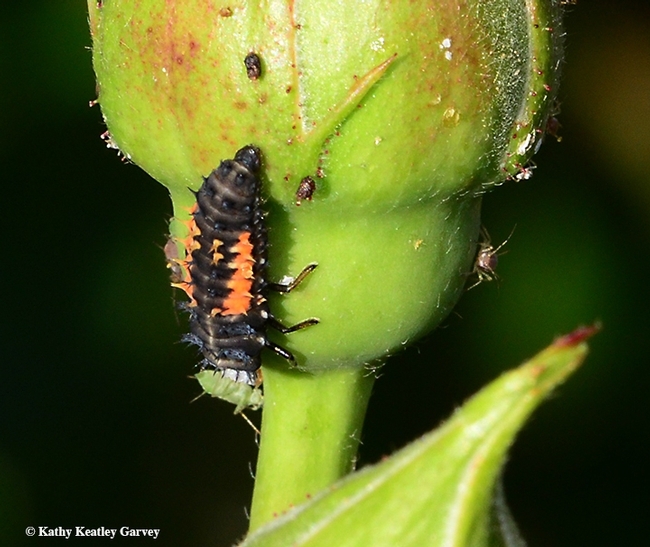
Larva of lady beetle munching on an aphid. (Photo by Kathy Keeatley Garvey)
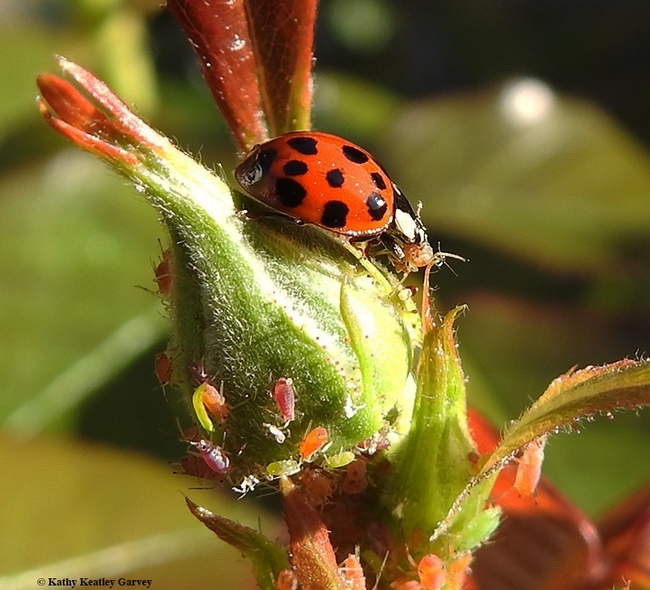
A multi-colored Asian beetles snags an aphid. (Photo by Kathy Keatley Garvey)
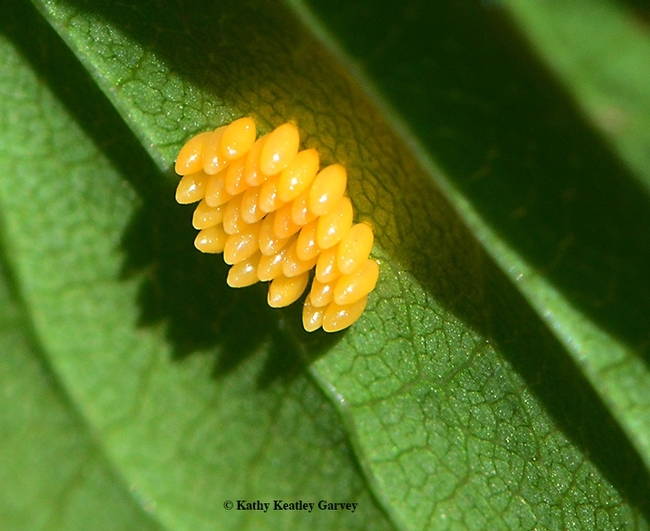
These are lady beetle eggs. (Photo by Kathy Keatley Garvey)
Good news for hedgerows: No effects on food safety in the field
Hedgerows enhance wildlife abundance and diversity around farmland without contributing to food safety problems in field crops, according to a new study published by a team of University of California researchers. The UC Agriculture and Natural Resources and UC Davis study documented that field edge plantings around farms are generally too narrow relative to the surrounding landscape to be a source of rodents and foodborne pathogens.
“This study is particularly pertinent right now when FDA's Food Safety Modernization Act (FSMA) is calling for farmers to co-manage wildlife and agriculture, instead of clear cutting wild habitat around their crops,” said co-author Rachael Long, UC Cooperative Extension farm advisor in the Sacramento Valley. “Our paper provides support for this ruling, showing that the presence of hedgerows does increase wildlife diversity, but does not increase wildlife intrusion into the fields and, more importantly, does not increase the prevalence of animals carrying foodborne pathogens.”
This is good news for hedgerows, rows of shrubs, trees, grasses and flowers that are planted on field edges. The plants bordering crop fields provide habitat and floral resources for beneficial insects, such as bees and natural enemies, that help with pollination and biocontrol of pests in adjacent crops. Hedgerows also help enhance biodiversity – especially for insect-eating birds – help reduce wind and soil erosion, and protect water quality.
The two-year study in Sacramento Valley walnut orchards and processing tomato fields was led by Long and Roger Baldwin, UC Cooperative Extension vertebrate pest control specialist at UC Davis, former graduate student Laurel Sellers, the Western Center for Food Safety at UC Davis's Michele Jay-Russell, Xunde Lib and Edward R. Atwill, and Richard M. Engeman of USDA National Wildlife Research Center.
The study, titled “Impact of field-edge habitat on mammalian wildlife abundance, distribution, and vectored foodborne pathogens in adjacent crops,” was published in the February 2018 Crop Protection (Sellers et al. 2018).
Elsevier is providing 50 days of free access to this article. Anyone clicking on the following link before March 31, 2018, will be taken directly to the article on ScienceDirect. No signup or registration or fees are required. Simply click and read at https://authors.elsevier.com/c/1WXU~xPFYej~4.
This journal article supports a growing body of literature suggesting that plantings along the edge of fields do not substantially attract wildlife species that intrude on fields and transfer foodborne pathogens. For example, in a 2015 study, UC Davis researchers found more food pathogens when wildlife habitat was reduced on farms. This may be attributed to the vegetation filtering pathogens, a better breakdown of pathogens in diverse environments, and that removing vegetation may not deter wildlife from entering farm fields.
Relative to the larger crop acreage, hedgerows and similar field-edge habitats are generally too linear and small to serve as a significant source of rodents to damage nearby crops. However, cottontail rabbits favor hedgerows, and can sometimes cause damage to adjacent seedling crops.
“Overall, we found risk of crop loss or contamination of foodborne pathogens in crops bordered by hedgerows wasn't significant in our study in the Sacramento Valley, although potential damage could vary by the stage and type of crop and wildlife species present,” Long said. She will be presenting this work at the 28th Vertebrate Pest Control Conference, which will be held in Rohnert Park Feb. 26 to March 1.
In its Standards for the Growing, Harvesting, Packing, and Holding of Produce for Human Consumption, the U.S. Food and Drug Administration says, "We continue to encourage the co-management of food safety, conservation, and environmental protection.”
Further reading:
Hedgerow benefits align with food production and sustainability goals. http://calag.ucanr.edu/archive/?article=ca.2017a0020
Comanaging fresh produce for nature conservation and food safety. http://www.pnas.org/content/112/35/11126
X


